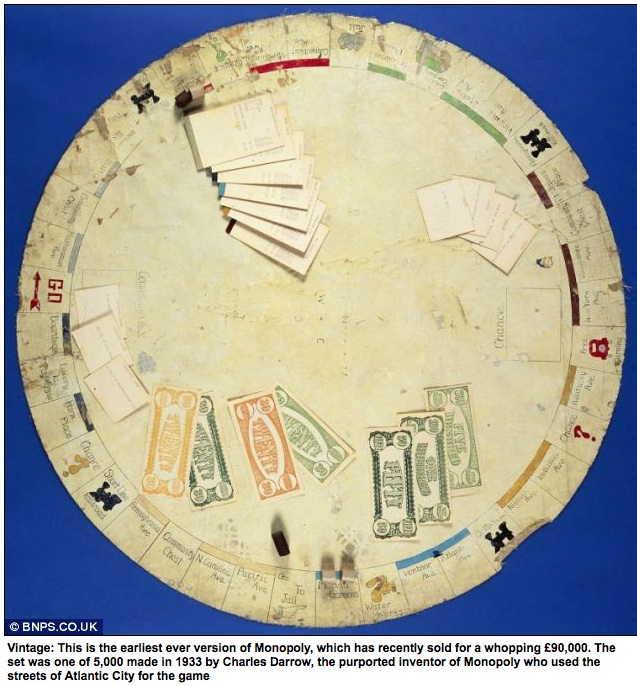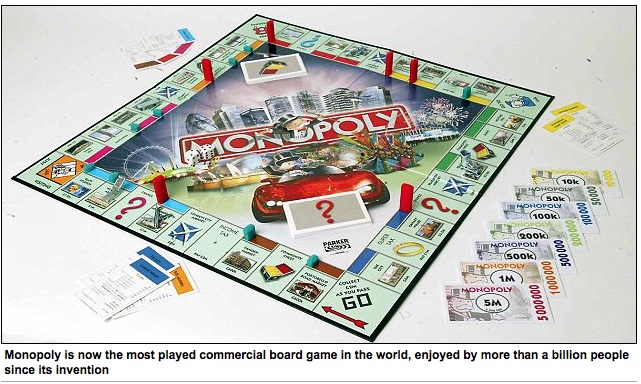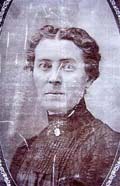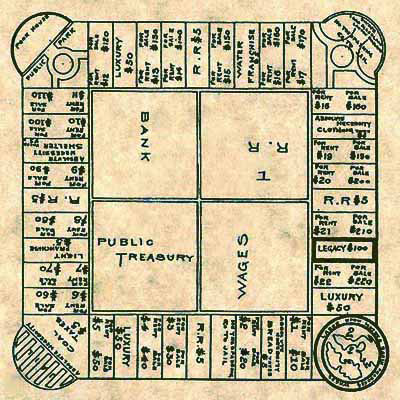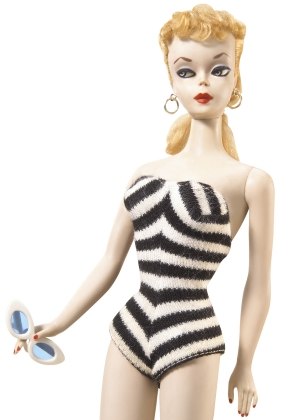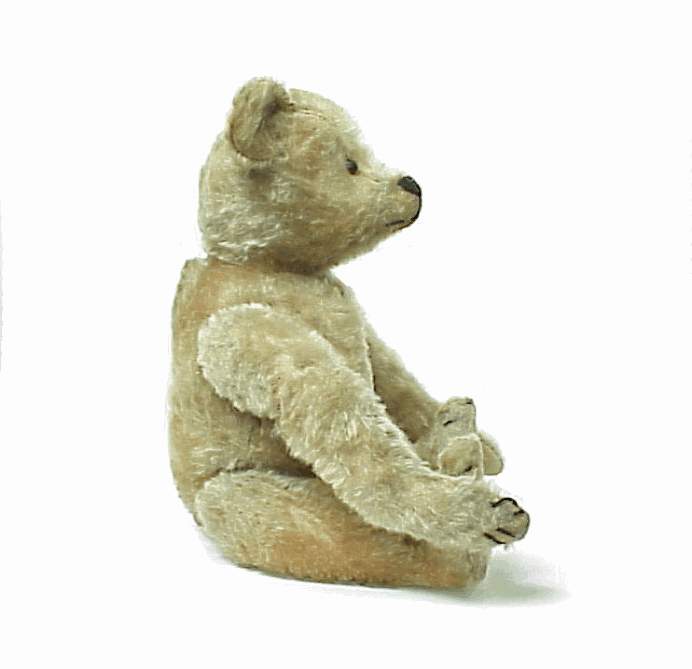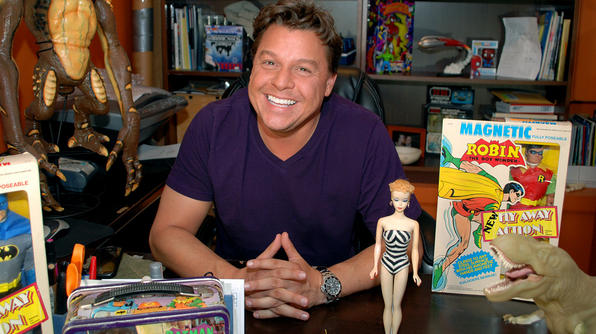The earliest ever version of the board game Monopoly has sold for a whopping £90,000.
The set was one of 5,000 made in 1933 by Charles Darrow, the purported inventor of Monopoly, and is the only one to have survived to this day.
The dog-eared set is made out of a piece of oilcloth and is in the form of the original circular shape that is 33 inches in diameter.
A BRIEF HISTORY OF THE POPULAR GAME
- In 1903, political activist Lizzie Magie invented The Landlord’s Game, which was made to teach people how monopolies end up giving vast wealth to only a few while many others struggle
- In 1933, James Darrow adapted Magie’s game to make an early form of Monopoly. His game was based on the streets of Atlantic City
- In 1941, the British Secret Service commissioned a special edition for WWII prisoners held by the Nazis. Each one was filled with hidden maps, compasses and real money, and were distributed by fake charity groups who were trying to help detainees escape
- In 1978, an all-chocolate edition of Monopoly was manufactured. The entire set, which retailed for $600, was edible, including the money, dice, hotels, properties, tokens and playing board
- In 1985, the world’s most expensive Monopoly set – worth around $2million – was produced. It is made of 23-carat gold, with rubies and sapphires atop the chimneys of the houses and hotels
MONOPOLY History & Fun Facts
The history of Monopoly begins long before Charles Darrow and Parker Brothers. To find the true beginnings we must travel back to 1904 and meet a woman named Elizabeth Magie (pronounced McGee). It was in this year that Lizzie was granted a patent for a board game called The Landlord’s Game. Lizzie was a Georgist and advocated his single tax theory.
The Landlord’s Game was designed as a learning tool to teach this theory. This game was published in 1906 by the Economic Game Company with less than stellar success. The game did however gain a cult following in the Northeast and Midwest through the teens and twenties. Most of these games were hand made and were amended as the maker saw fit. Elizabeth Magie-Phillips (now married) obtained a new patent on an updated Landlord’s Game in 1924.
Key to this story are four people; Dan Layman, Ruth Hoskins, Jesse Raiford, and Charles Todd. Layman learned The Landlord’s Game/Monopoly while in school and decided to publish it. He was told by his lawyers that the name Monopoly was in the public domain and therefore could not be trademarked, so he decided to publish the game under the name Finance. Electronic Laboratories and then Knapp Electric started publishing Finance in 1932 in Indiana(by 1935 Finance was outselling Monopoly 10 to 1).
Now, Ruth Hoskins was taught the game by Dan Layman and took it with her to Atlantic City. Here she and some friends played the game, changing the names of the properties to local, Atlantic City, street names (some of the spaces were rearranged and some property values were changed). Jesse Raiford was in this circle of friends. Raiford taught the game to Charles Todd who took it home with him to Germantown, PA.
In 1933 Charles Darrow learned the game of Monopoly from Charles Todd, a friend of Darrow’s wife. Darrow fell in love with the game and began selling handmade games to his friends. Soon, demand increased so much Darrow had to enlist the help of a printer to get sets made more quickly. Two all-inclusive white editions were produced in 1934 and a small black box edition with a separate board was produced in 1935. Darrow tried to sell the game to Parker Brothers and Milton Bradley in 1934, but neither firm was interested. In 1935 Monopoly again came to attention of Parker Brothers and at this time they decided to purchase and produce the game. (For a much more detailed account of the early history read Monopoly: The World’s Most Famous Game & How It Got That Way By Philip E. Orbanes.
Parker Brothers wanted a “monopoly” on Monopoly so they began trying to squash the competition. George Parker went to visit Lizzie Magie-Phillips to try to acquire her 1924 Landlord’s Game patent. The two knew each as Parker Brothers had published some of her games in the past and she considered George Parker the “King of Games”. The negotiation over the purchase was an easy one, Parker Brothers would pay Mrs. Magie-Phillips $500 and agree to publish a few more of her games including The Landlords Game (this was done in 1939 again with very little success). Patent number 1,509,312 now belonged to Parker Brothers.
Knapp (Electronics Laboratories) was another story. Already outselling Monopoly and beginning to market the game on a national level they weren’t convinced as easily. It took $10,000 of Parker Brothers Money (a huge amount in depression torn 1935) to convince Knapp to sell. Parker Brothers then changed Finance completely and, hiding behind a dummy company (The Finance Game Company), filled Knapp’s outstanding orders. In 1936 the board and rules were again changed slightly and Finance became a Parker Brothers game.
Parker Brothers wasn’t about to put all its eggs in one basket though. They had Darrow file for a patent, but knowing the true history of Monopoly they decided to produce their own version of the game. Fortune was the result of this work. As few as 5,000 of these games were made in 1935 before patent 2,026,082 was granted giving Parker Brothers proprietary rights to Monopoly. The name Fortune was then added to Finance which became Finance and Fortune until Parker Brothers used the name Fortune for another game in 1958
Connections with Academe
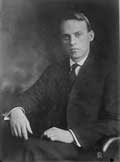 Around 1900, Scott Nearing was introduced to The Landlord’s Game by either Lizzie Magie or other residents of Arden. He was at the time a full-time resident of Arden. Nearing went on to become a member of the economics department at the University of Pennsylvania in 1906, where he used The Landlord’s Game in his teaching. His support of Henry George’s proposals to raise pubic revenue exclusively from those who owned land, and his opposition to child labor, caused him to be dismissed from the university in 1915.
Around 1900, Scott Nearing was introduced to The Landlord’s Game by either Lizzie Magie or other residents of Arden. He was at the time a full-time resident of Arden. Nearing went on to become a member of the economics department at the University of Pennsylvania in 1906, where he used The Landlord’s Game in his teaching. His support of Henry George’s proposals to raise pubic revenue exclusively from those who owned land, and his opposition to child labor, caused him to be dismissed from the university in 1915.
Burton H. Wolfe, in “The Monopolization of Monopoly” (San Francisco Bay Guardian, 1976), says that “Nearing played The Landlord’s Game with his brother, Guy Nearing, who lived in the Henry George single tax community of Arden, Delaware.” Then:
As the students and single taxers played the game, they began a process … of altering the rules. The main change was that instead of merely paying rent when landing on a property block, the players could hold an auction to buy it. They also made their own game boards so that they could replace the properties designated by Lizzie Maggie with properties in their own cities and states; this made playing more realistic. As they drew or painted their own boards, usually on linen or oil cloth, they change the title “Landlord’s Game” to “Auction Monopoly” and then just “Monopoly”.
Burton Wolfe also tells us that a young Rexford E. Tugwell was one of the players. One of Tugwell’s own students, Priscilla Robertson — long-time editor of The Humanist — provided the following details on the early history of the game: “In those days those who wanted copies of the board for Monopoly took a piece of linen cloth and copied it in crayon. It was considered a point of honor not to sell it to a commercial manufacturer, since it had been worked out by a group of single taxers who were anxious to defeat the capitalist system.” (I am obliged to note here the considerable misrepresentation of the objectives pursued by Single Taxers who shared Henry George’s principles. Defeating monopoly in all its forms (but, particularly, monopoly of nature), not capitalism, was – and is – the cause embraced then and today.)
Other writers note the game was played by students at Princeton University and Haverford College. Changes were made to the board design, gathering the properties into groups, allowing buildings to be added to the locations and increasing the amount of rent charged based on the number of like properties owned.
Other writers note the game was played by students at Princeton University and Haverford College. Changes were made to the board design, gathering the properties into groups, allowing buildings to be added to the locations and increasing the amount of rent charged based on the number of like properties owned.
By the late 1920s, the version of the game being played by college students and others had evolved quite a bit from Elizabeth’s design. The game was now generally referred to as “Monopoly.” A young student at Williams College (Reading, Pennsylvania) produced a commercial version under the name Finance, but the game was essentially Monopoly. Then, a woman named Ruth Hoskins who learned the game in Indianapolis moved to Atlantic City, New Jersey and supposedly created the version that included the Atlantic City street names.
Then the plot thickens. The game was introduced by Eugene (Colonel) and Ruth Raiford, friends of Ruth Hoskins, to Charles Todd, who lived in Germantown, Pennsylvania; and, Charles Todd then introduced the game to Charles and Esther Darrow. Eugene Raiford, Charles Todd and Esther Jones Darrow all attended the Quaker Westtown School from 1911 to 1914 or 1915. The subsequent connection with Atlantic City occurred because of the close association of the Westtown School with the Atlantic City Friends’ School. As Todd later recalled: “The first people we taught it to after learning it … was Darrow and his wife Esther. …It was entirely new to them…. Darrow asked me if I would write up the rules and regulations and I wrote them up … and gave them to Darrow.”
Enter Charles Darrow and Parker Brothers
 During the last few decades, details of how the game Monopoly came to be owned — and the profits from sales monopolized — have come to light because of circumstances that could not be controlled by Parker Brothers.
During the last few decades, details of how the game Monopoly came to be owned — and the profits from sales monopolized — have come to light because of circumstances that could not be controlled by Parker Brothers.
Charles Darrow was the first to capitalize on the evolution and popularity of the game. He secured a copyright for his enhanced edition of the game in 1933. The familiar cardboard board, packaged in a white box, was produced and sold locally in Philadelphia. In 1935, Darrow submitted the game to the U.S. Patent Office and was granted a patent. The game’s origins apparently were not appreciated by the Patent Office clerks. Sales of the game mushroomed, and Charles Darrow became wealthy. Parker Brothers became a major company on the profits of Monopoly.
Challenges to Monopoly’s Monopoly
Much of the credit for the recent interest in The Landlord’s Game, Elizabeth Magie Phillips and the connection to Henry George’s social and economic philosophy belongs to Ralph Anspach.
In 1973, while on the economics faculty of San Francisco State University, Professor Anspach designed a new game, which he called Anti-Monopoly. When Anspach’s game began to compete with Monopoly on store shelves, General Mills (successor to Parker Brothers) filed a lawsuit against Proessor Anspach for patent infringement. A decade-long legal battle ensued during which the lower court actually ordered thousands of copies of Anti-Monopoly destroyed.
Professor Anspach presented the historical evidence revealing that Charles Darrow essentially taken the game virtually without change in the design or rules from the version produced by Charles Todd. The details of the legal battle to regain ownership rights is provided at the Anti-Monopoly website.
Getting back to Elizabeth Magie Phillips
References to Elizabeth’s endeavors appear in Georgist periodicals. In a 1926 issue of Land and Freedom, it was announced that “a group of Single Taxers contemplates a new and improved edition of the Landlord’s Game.” Elizabeth also remained an active Single Taxer, and in 1931 was a delegate to the Henry George Congress held in Baltimore, Maryland during October.
Parker Brothers purchased Elizabeth’s patent in 1932 for $500, under condition that Parker Brothers would continue to publish The Landlord’s Game as well as Monopoly. Burton Wolfe describes a meeting the Parker Brothers President, Robert Barton and Elizabeth:
So, Barton met with Lizzie Magie, he testified, and asked her if she would accept changes in her game. According to Barton’s recollection, she replied like this: “No. This is to teach the Henry George theory of single taxation, and I will not have my game changed in any way whatsoever.” For John Droeger of San Francisco, the lawyer taking his deposition, Barton explained why in his opinion Lizzie Magie answered that way: “She was a rabid Henry George single tax advocate, a real evangelist; and these people never change.”
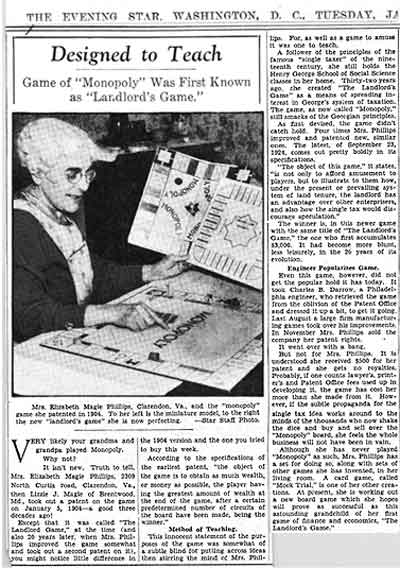 In a January 1936 interview in The Washington Star, Elizabeth was asked “how she felt about getting only $500 for her patent and no royalties ever. She replied that it was all right with her “if she never made a dime so long as the Henry George single tax idea was spread to the people of the country.”
In a January 1936 interview in The Washington Star, Elizabeth was asked “how she felt about getting only $500 for her patent and no royalties ever. She replied that it was all right with her “if she never made a dime so long as the Henry George single tax idea was spread to the people of the country.”
A third edition of The Landlord’s Game was published by Parker Brothers in 1939, but the company did nothing to promote it. In fact, the game was almost immediately recalled from stores and almost every unsold copy destroyed. Today, very few copies survive. Consistent with the agreement with Elizabeth, the game came with two sets of rules. However, only the rules copyrighted by Parker Brothers were actually sold with the game. Purchases were required to contact Elizabeth Magie Phillips to obtain the alternative rules. Remarkably, Elizabeth’s rules were made available by Hasbro on the company’s website.
An essay written by Elizabeth appeared in the September-October 1940 issue of Land and Freedom, under the title “A Word to the Wise.” Even in her declining years, she was urging surviving Single Taxers to action:
What is the value of our philosophy if we do not do our utmost to apply it? To simply know a thing is not enough. To merely speak or write of it occasionally among ourselves is not enough. We must do something about it on a large scale if we are to make headway. These are critical times, and drastic action is needed. To make any worthwhile impression on the multitude, we must go in droves into the sacred precincts of the men we are after. We must not only tell them, but show them just how and why and where our claims can be proven in some actual situation….
Elizabeth Magie Phillips died in 1948 in Arlington, Virginia.
High Profile Sets
 The original White Box edition, mass produced by Darrow and sold at Wanamaker’s Department Store in Philadelphia in the early 1930’s, is the forerunner of the game first produced by Parker Brothers. There are no numbers in the corners of the money, only in the center. There are no tokens as the instructions say to provide each player with their own token. And there are no values showing on the squares on the board.
The original White Box edition, mass produced by Darrow and sold at Wanamaker’s Department Store in Philadelphia in the early 1930’s, is the forerunner of the game first produced by Parker Brothers. There are no numbers in the corners of the money, only in the center. There are no tokens as the instructions say to provide each player with their own token. And there are no values showing on the squares on the board.
Forbes Magazine purchased three early monopoly sets at auction. One had a square board, like the printed Parker Brothers’ games and a price tag of $23,000. It came with unpainted houses and hotels cut from pine molding, old chips, scrip, and typed Chance and Community Chest cards, deeds, and a set of rules typed on the same typewriter as the rules that accompanied the set Forbes purchased in December 1992. That set has a circular oilcloth board, probably an earlier version made for use on Darrow’s round dining table.
Another set, and a key one in the development of Monopoly cost $17, 250. It’s laid out on a 22-inch square of pale blue glazed fabric with properties marked by colored triangles at the bottom, instead of bars at the top. It came with red-roofed, gray-painted houses and hotels, Chance cards, deeds, and money. It belonged to Charles E. Todd, who taught Darrow the game.
A third set, a wooden hand-painted square game board that cost $11,500 at auction, is probably earlier than the others. It has 40 board divisions like the Atlantic City sets, but the place names are for real estate in the counties surrounding Philadelphia: Kimberton, Trappe, Ambler, Valley Forge, etc. More closely related to the original Landlord’s Game, it has one corner marked “Mother Earth” instead of “GO,” and another corner square reads “Government Grant, No Rents, No Taxes, Rest in Peace, and Depart” instead of “Free Parking.” Joseph A. Buckwalter made this game in the 1920s.
Success
Today, Monopoly is the best-selling board game in the world, licensed or sold in 80 countries and produced in 26 languages including Croatian. It’s so much a part of today’s popular culture that Parker Brothers have trademarked many of its graphic elements, including the tokens, Railroad, Community Chest, Chance, and Title Deed designs, as well as Boardwalk and all four gameboard corners.
Many editions of Monopoly exist beyond the standard one. There are anniversary editions, luxury editions with solid mahogany boards with drawers to store the playing pieces, European editions, classic editions, standard editions, travel editions, junior editions, etc. Classic editions are re-issues of earlier versions, namely those that came in a black box with a separate board.
Standard editions are the most frequent occurring sets, although the appearance continuously changes, depending on the time of issue. In the early days, Parker Brothers issued many nearly equal but slightly different versions, and since they bear no reference numbers it’s very hard to distinguish and catalogue them.
Who Collects Monopoly
A small but enthusiastic group of collectors collect Monopoly games. They collect the “official” Parker Brothers’ games as well as the “related” games like the States, Cities and University games, and Medical Monopoly (USA).
Collectors should use copyright dates printed on the board to date their games. Even though Parker Brothers’ earliest date is 1935, they left “Charles Darrow 1933” on the jail square in eight successive sets. Earlier games didn’t have property prices printed on the board. Also, Chance, Community Chest, and Luxury Tax cards have only text and no illustrations. The property cards are also blank on older sets. Originally, the rent for Marvin Gardens was $22 but was later changed to $24.
The Monopoly Market
While most monopoly games are worth a modest sum, some of the rarer editions have sold for five figures. The Forbes magazine collection has a monopoly on old Monopoly games. They acquired three of them in 1994 for $11,500, $17, 250 and. $23,000, adding to the one they bought in December 1992 for $71,500. But most early standard games sell for around $100 in perfect condition.
The playing pieces sell for anywhere from $2 to $20 each. One of the rarest tokens is the purse, found in only very early editions. It sells now for $19. The original set sold by Parker Brothers retailed for $2. Today, these same sets can go for $100 or higher , with the game boards alone selling for at least $50 in good condition.
Since 1935, its first year under Parker Brothers’ ownership, Monopoly has been played by an estimated 500 million people. Today, many versions exist, with over 200 million games having been sold worldwide. A set made by Alfred Dunhill, with gold houses and silver hotels, sold for $25,000. The longest game in history lasted 70 straight days. The longest game in a bathtub lasted 99 hours!
Fun Facts
- More than 275 million games have been sold worldwide and it’s available in 111 countries, in 43 languages.
- The longest MONOPOLY game in history lasted for 70 straight days.
- Many specialized editions of the classic game have been produced featuring your favorite sports teams, brands, television shows, cartoons and more.
- The most expensive version of the game was produced by celebrated San Francisco jeweler Sidney Mobell. Valued at $2 million, the set fea tures a 23-carat gold board and diamond-studded dice.
- The character locked behind the bars is called Jake the Jailbird. Officer Edgar Mallory sent him to jail.
- Children play MONOPOLY all over the world, but where they live may determine what they call the highest rent property on the game board. In the U.S., it is named “Boardwalk” after a street in Atlantic City. In Spain, it is named “Paseo del Prado” after a street in Barcelona and in France, “Rue de la Paix” is the name of the most coveted property space.
- Escape maps, compasses and files were inserted into MONOPOLY game boards smuggled into POW camps inside Germany during World War II. Real money for escapees was slipped into the packs of MONOPOLY money.
- Every few years, national champions from around the globe meet for the MONOPOLY World Championship tournament. World Champions have hailed from 10 different countries, including: United States, Ireland, Singapore, Italy, New Zealand, United Kingdom, Japan, Netherlands, Hong Kong, Japan and Spain.
- More than six billion little green houses and 2.25 billion red hotels have been “constructed” since 1935.
- Since 1935, more than one billion people have played the game.
- Over 20 tokens have been cast since the MONOPOLY game was introduced in 1935 such as the horse, dog, car, elephant, purse and lantern.
- Demand for MONOPOLY skyrockets and it quickly becomes America’s No.1 game!
- More than just a game – MONOPOLY is used by British Secret Service in WWII.
- Our beloved tokens! In the early 1950s, the lantern, purse and rocking horse were removed from the game. They were replaced by the dog, horse and rider, and wheelbarrow.
- In the 1970’s, a Braille edition of the MONOPOLY game was created for the visually impaired.
- In 1972, the Commissioner of Public Works in Atlantic City, New Jersey, the real life model for the game,, threatened to change the names of the real Baltic and Mediterranean Avenues, but public outcry vetoed the bill.
- In 1978, the Neiman Marcus Christmas catalog offered a chocolate version of the game priced at $600.
- Money and property ownership symbolize success in the 1980’s and the MONOPOLY brand seems to match up. Localizations, licenses, and spin-offs of MONOPOLY allow people all over the world to live the dream of owning it all.
- MONOPOLY develops strategic partnerships (MONOPOLY at McDonald’s promotion) and brand extensions (first CD-Rom game) becoming a recognizable cultural icon including becoming a US postage stamp!
- MONOPOLY has launches on seven platforms in 27 countries, and is localized into 20 languages with nearly 10 million worldwide mobile phone game downloads.
- Tokens from the United States MONOPOLY: Here & Now Edition were flown into space aboard Space Shuttle Atlantis in 2007.
- In 2008, MONOPOLY fans around the world united to set the world record for the most people playing MONOPOLY at the same time to commemorate the launch of MONOPOLY Here & Now: The World edition. Nearly 3,000 people “passed GO” at events around the world.
- “Best Mobile Game Award” at the 2008 Mobile Excellence Awards (MONOPOLY Here & Now on feature phone)
- “Best Dice Game” at the 2009 Best App Ever Awards (MONOPOLY Classic on iPhone)
- “Best Game inspired by a Board Game” at the 2009 AppAdvice App Awards (MONOPOLY Here & Now on iPhone)
- In 2009, MONOPOLY and Google partner to launch MONOPOLY City Streets. The 3 month game had more than 1.4MM registered players, from across the world generating 17 million visits and nearly a billion page views while purchasing nearly 9 million streets and constructingmore than 175 million buildings.
- MONOPOLY’s most recent extensions: Apple iPhone – February 2010Pop Culture
- In the movie Zombieland, Tallahassee and Little Rock pass the time playing MONOPOLY with real money.
- Under The Boardwalk, a documentary about MONOPOLY is scheduled to debut fall 2010. It will feature interviews and profiles from the world’s top competitors, commentary from a MONOPOLY expert, along with fanatics and collectors and a history of the game.
- MONOPOLY Classic for iPhone was voted “Best Dice Game” at the 2009 Best App Ever Awards.
- In the book and the movie One Flew Over the Cuckoo’s Nest, McMurphy joins the patients in a game of MONOPOLY. In the movie, the game gets so heated that McMurphy ends up hosing down the other players with cold water.
- In one of President Obama’s State of the Union addresses he referenced MONOPOLY money: The fact is, Washington is a place where tax dollars are often treated like MONOPOLY money, bartered and traded, divvied up among lobbyists and special interests. And it has been a place where waste – even billions of dollars in waste – is accepted as the price of doing business,” said President Obama. “Well, I don’t accept business as usual. And the American people don’t accept it either, especially when one of the most pressing challenges we face is reining in long-term deficits with threaten to leave our children a mountain of debt.
- MONOPOLY Here & Now for iPhone was voted “Best Game inspired by a Board Game” at the 2009 AppAdvice App Awards.
- In a Chumbawumba song entitled “Don’t Pass Go” they sing:Well the facts said ‘yes’
But the judge said ‘no’
Go straight to jail
He didn’t understand
And he told them so
Go straight to jail
And don’t pass go
Don’t pass go - MONOPOLY match-ups are common between the fictional Humphrey family on Gossip Girl. Wannabe designer Jenny Humphrey aptly chose the thimble token.
- MONOPOLY Here & Now on feature phone was voted “Best Mobile Game Award” at the 2008 Mobile Excellence Awards
Official Recognized Monopoly Marathon Records:
- Longest Game Ever Played—1,680 hours (70 days)
- In a treehouse—240 hours (10 days)
- In a moving elevator—384 hours (16 days)
- Underground—100 hours (4 days 4 hours)
- In a bathtub—99 hours (4 days 3 hours)
- On a balance beam—200 hours (8 days 8 hours)
- Underwater—1,200 hours (50 days)
- On the back of a fire truck—101 hours (4 days 5 hours)
- Anti-gravitational game—36 hours
- Largest outdoor game—938 x 765 feet
- Largest indoor game—122 x 122 feet
- Smallest game—1 square inch. for 30 hrs.
Credits:
MONOPOLY
http://www.worldofmonopoly.com/
http://www.monopolycollector.com/

